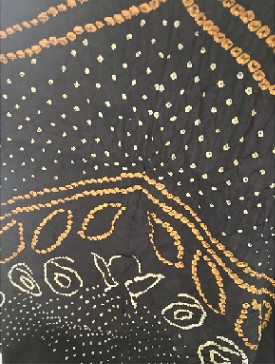The art of Bandhani is a highly skilled process. The technique involves dyeing a fabric which is tied tightly with a thread at several points,thus producing a variety of patterns. The main colours used in Bandhani are yellow, red,blue, green and black. Bandhani work, after the processing is over, results into a variety of symb-ols including, dots, squares, waves and strips. The main colours used in Bandhani are natural.. All colours in bandhani are dark as no light colour is used. The background is mostly in black / red cloth. A meter length of cloth can have thousands of tiny knots known as "Bheendi" in Cutchi language. Four bheendis make one as a "Kadi". The knots form a design once opened after dyeing.
This art and the beautiful printed cottons of India are mentioned in the texts of Alexander the Great's time . Tradition has it that the first Bandhani saree was worn at the time of Bana Bhatt`s Harshacharita in a royal marr-iage. It is believed that wearing a Bandhani saree can bring good luck to a bride. Ajanta walls stand eviden-ce for these Bandhani Sarees,. Khombi and Patori were essential parts of the Cutchi female costume. Odhnis (Munalmo), sarees and turbans in Bandhani.of Cutch are famous. Different communities have for ages followed the tradition on tying turbans with different patterns of bandhani on their heads. These were used to identify the community the person belonged to.
Traditionally, the final products can be classified into "Khombhi", "Ghar Chola", "Patori", "Chandrokhani" etc. In Bandhani, different colors convey different meanings. While red (Suhagadi) represents a bride, a yellow background (Satbandeli) suggests that a lady has become a mother recently.
The Bandhani work has been exclusively carried out by the Khatri community of Kutchh. Bhuj and Man-dvi of Kutch District are well known for the finest quality of bandhani. The history of dyeing can be dated back to pre-historic times, say around 3000 BC. This art and the beautiful printed cottons of India are mentioned in the texts of Alexander the Great's time .
The Bandhani work has been exclusively carried out by the Khatri community of Kutchh. Bhuj and Man-dvi of Kutch District are well known for the finest quality of bandhani. The history of dyeing can be dated back to pre-historic times, say around 3000 BC.
This art and the beautiful printed cottons of India are mentioned in the texts of Alexander the Great's time . Tradition has it that the first Bandhani saree was worn at the time of Bana Bhatt`s Harshacharita in a royal marr-iage. It is believed that wearing a Bandhani saree can bring good luck to a bride. Ajanta walls stand eviden-ce for these Bandhani Sarees,. Khombi and Patori were essential parts of the Cutchi female costume. Odhnis (Munalmo), sarees and turbans in Bandhani.of Cutch are famous. Different communities have for ages followed the tradition on tying turbans with different patterns of bandhani on their heads. These were used to identify the community the person belonged to.
Bandhani came to Kachchh when members of the Khatri community migrated from Sindh. in the 12th century AD. Bandhani tie and dye became a staple local source of income with the export of bandhani to Europe via the English East India Company in the 18th century. Much like the local block printers, bandhani artisans used local, natural resources like madder and pomegranate to dye their cloth in a brilliant range of hues. The technique of tightly winding a thread around a section of cloth, dyeing it, and then removing the thread to reveal a circular resist motif has remained the same since bandh-ani was first practiced. However, with the economic crisis of post 1956 earthquake khatris were forced to change over to cheaper artificial dyes Even so quality bandhani fabrics still use natural dyes. The Bandhani fabric is sold with the points still tied and the size and intricacy of the design varies according to the region and demand. Knots are removed and the fabric ironed to smooth at the time of first use.
A Magazine for the Cutchi Memon Community of Kerala
THE BANDHINI
Dr. J.M.I. Sait PhD FCMA, DipMA, FCS, FBIM, DIOMI, MAAA, MMI
A well known traditional fabric of Cutch is the bandhini a meticulously designed tie and dye fabric. A Cutchi woman would fel incom-plete without a bandhini oufit. It is an an old tradition to make bandhini sarees, misr (head scarf) etc.









